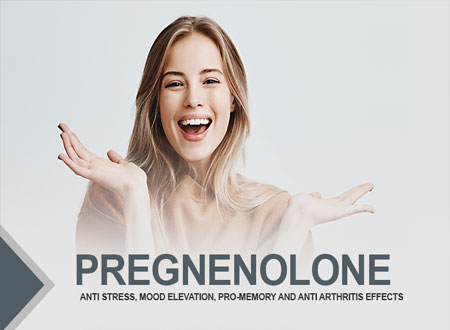



Pregnenolone and Mental Function
Pregnenolone is the precursor (building block) for all other steroid hormones. It is converted directly into DHEA and/or progesterone. DHEA converts to testosterone and estrogens progesterone converts to estrogens, cortisol, and aldosterone. It is this succession of conversions that makes human life possible. Without pregnenolone, there can be no human steroid hormone production.
Made from cholesterol, pregnenolone is a natural steroid-hormone produced primarily in the adrenal glands, but in smaller amounts by many other organs and tissues of the human body, including liver, brain, skin, gonads, and even the retina of the eye.
Like many health-promoting hormones, levels of pregnenolone drop with age. Although the data are not as abundant or definitive for pregnenolone as they are for DHEA, Dr. Eugene Roberts, a pioneer in hormone research, believes that the age -related drop in pregnenolone is as dramatic as the drop in DHEA. At 75, our bodies typically make 60% less pregnenolone than at age 35. This is a point of great concern, considering pregnenolone’s numerous protective, health promoting properties.

Animal studies by Isaacson, Flood, Merely and Roberts have shown that injection of as few as 15 to 145 molecules (!) of pregnenolone directly into the areas of the brain which are thought to mediate memory, improved the ability of mice to more quickly remember the way out of a maze that they had run before. Preliminary results of St. Louis School of Medicine researcher R. Sih have shown definite memory enhancement with pregnenolone. Dr. Sih gave 500-mg pregnenolone or a placebo to men and women three hours before they were asked to perform standard memory tests. Pregnenolone resulted in improved memory in both men and women, improved spatial memory and perception in men, and improved verbal recall memory in women.
Pregnenolone is known to modulate at least two key nerve receptor systems in the brain NMDA receptors and GABA receptors. NMDA receptors, which decrease with age, are involved in learning, memory, and alertness. Pregnenolone enhances NMDA receptor function. GABA receptors promote relaxation, mental slowing, sedation and sleep. Benzodiazepine drugs (Valium, Librium, Xanax, etc.) activate GABA receptors, while pregnenolone inhibits GABA receptors. Thus, too little NMDA activity combined with excessive GABA activity would tend to promote mental sluggishness and depression. Since pregnenolone raises NMDA activity and lowers excessive GABA activity, pregnenolone seems to be a natural antidepressant. Indeed a recent study of 27 depressed patients found that their cerebro-spinal fluid (which circulates through the brain and spinal cord) was significantly lower in pregnenolone than in 10 non-depressed volunteers. Cerebrospinal fluid levels are generally believed to accurately reflect levels of various biochemicals in the brain.
During the 1940’s, pregnenolone was used successfully as a treatment for rheumatoid arthritis. A 1950 review article on pregnenolone reported on a study by Henderson and colleagues which found that 300 mg pregnenolone/day for 40 days resulted in a significant decrease in joint pain, tenderness, and spasticity, with improved strength and range of motion. Another study by Freeman and colleagues, with 64 patients, used 500 mg of pregnenolone daily for periods of 2 to 30 weeks. 24 patients showed striking improvements, and 20 showed minor improvements.


Unfortunately, the advent of the “wonder drug” cortjsone (Cortisol) in the 1950’s caused pregnenolone to be passed by for arthritis treatment, since pregnenolone’s results were much slower to manifest. “Coincidentally”, pregnenolone couldn’t be patented by the drug companies whereas synthetic variants of cortisone could be (and were) patented. By the time the nightmarish side effects of excessive cortisone were widely known by the medical community in the 1960’s (these side effects could include psychotic breakdown, adrenal failure, and even death), pregnenolone had been completely forgotten.
Small amounts of cortisol are essential to promote health and even for life itself. Yet under the prodding of chronic stress and aging, our adrenal glands often over-produce cortisol. Indeed, coltisol is the only steroid hormone whose levels tend to increase with age. The level of all other steroids, including pregnenolone, tend to decrease (often radically) with age. Excessive cortisol promotes a host of negative side effects. High cortisol levels promote depression, as does chronic, unremitting stress in many people (which results in chronically elevated cortisol). Experimental subjects such as factory workers and airplane pilots who were given pregnenolone under stressful conditions actually reported an enhanced sense of well being and happiness.
The following are indications of an excessive cortisol level:
A major determinant of the body’s ability to detoxify poisonous chemicals – such as pesticides, medical drugs, industrial contaminants and auto exhaust – is the health and effectiveness of the Cytochrome P450 enzyme system in the liver. This is one of the most broad-spectrum, universal detoxifying enzyme systems possessed by all mammals, including humans. Moderate levels of cortisol (the “state-of-siege” anti-stress hormone) promote the activity of this deter system. However, larger amounts of cortisol (which is all-too-often over-produced by our adrenal glands due to aging or prolonged stress) degrade the P450 system’s anti-toxin effects. Although pregnenolone does not affect the rate of synthesis of the enzymes in the P450 system, it does stabilize these enzymes against the digestive activity of liver proteolytic enzymes, which would tend to break down the P450 enzymes. Pregnenolone thus increases overall P450 deter enzyme power by promoting conservation of existing P450 enzymes.
Safety
Fortunately, pregnenolone is amazingly safe, far safer than other steroids. Pregnenolone researchers working with both human and animal subjects since the 1940’s have consistently commented on pregnenolone’s virtual absence of toxicity. For example, the classic review article on pregnenolone by Henderson and colleagues in 1950 states: “it [pregnenorone] has an extremely low order of toxicity; has not shown any adverse effects on endocrine [hormone] physiology ….”
Pregnenolone has been given orally to humans at doses as high as 500 mg/day for as long as 30 weeks without evidence of adverse effects. Mice given 5 grams (1/6 ounce) per kilogram (2.2 pounds) of body weight suffered no ill effects. This would be equivalent to a 154 pound CIO kilogram) human ingesting 350 grams (approximately 3/4 pound) per day! In a long-term study, mice that were given one-gram pregnenolone per kilogram of body weight three times weekly for 50 doses suffered no toxic reaction – including no changes in the size and condition of offspring produced after the 50 doses.
In one human study, eight people received 50 to 150 milligrams per day by intramuscular injection for 75 days, with no reported side effects. Dr. Eugene Roberts gave 20 Alzheimer’s patients 525 mg/day for three months with no toxicity. During rheumatoid arthritis experiments with pregnenolone, Dr. H. Freeman and colleagues gave 500-mg pregnenolone/day for up to 30 weeks, with no toxicity. And Drs. Pincus and Hoagland, two of the pioneer researchers on pregnenolone use by humans in the 1940’s, found no toxic reactions with pregnenolone used by hundreds of men and women at dosages of 100 mg/day for four months.
Dosage
The classic studies on pregnenolone and stress in the 1940’s by Pincus and Hoagland generally used only 50 mg/day to achieve excellent results, while arthritis studies typically used 200-500 mg daily.
For those wishing to err on the side of caution, 50 to 100 mg pregnenolone per day would probably be suitable for use without physician monitoring. Perhaps an additional safety margin (for this already amazingly safe substance) could be achieved through discontinuing use for one week every month. Those wishing to use the higher, anti -arthritis doses (200 – 500 mg/day) should probably do so only under the supervision of their physician, even though many human clinical studies with arthritis at these dosages yielded no problems or toxicity. Morning is the perfect time to take pregnenolone, and a single daily dose is probably best, since pregnenolone is fat-soluble, and probably follows the circadian highs and lows of DHEA and cortisol (highest in the morning, with a drop to baseline by late afternoon). On a personal note, I have taken 100 – 1,000 mg pregnenolone/day intermittently since 1987, with no discernible negative side effects.
Contraindications
While there has been no definite information published as to who should not take pregnenolone, on theoretical grounds, a few cautions can be suggested. Since pregnenolone (especially at high doses) may in some people increase estrogen or testosterone levels, I believe that men with prostate cancer (which may be worsened by testosterone) and women with breast or ovarian cancer (which may be worsened by estrogen) should probably take pregnenolone only with their doctor’s consent and supervision. Men with high PSA (prostate specific antigen) blood levels a possible indicator for undiagnosed or future prostate cancer should also proceed with caution with pregnenolone use. Lastly, because of pregnenolone’s anti-GABA, pro-NMDA action, persons known to suffer from epileptic seizures or who are taking an anti-seizure medication such as Dilantin, Depakote or Tegretol should probably only use pregnenolone with their doctor’s supervision. Finally, as we age, the body produces ever less of the enzyme which converts pregnenolone to DHEA. Thus, while supplementary pregnenolone taken during middle age and beyond will produce at least some normalization back toward more youthful (and healthful) levels of other steroid hormones, pregnenolone will not completely substitute for other steroid hormone supplements in those with medically demonstrated needs for various specific steroids i.e., DHEA, cortisol, estrogen, etc.
References:
Watch Dr. Golding talk on Integrative and Anti-Aging Medicine.
Sign up for our newsletter to find out more about the exciting world of integrative medicine
